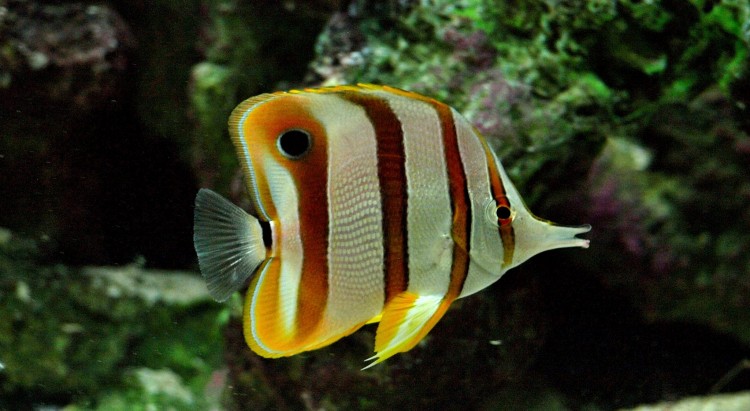Copperband Butterflyfish the Difference Between Success and Death
- Sep 07, 2019
- PalaciosAn
- 5766 0 0

The Copperband butterflyfish is not a fish for beginners. It is a fish for hobbyists who have a bit of experience and are willing to put in the work to keep them healthy.
Its unique features can easily recognize the Copperband butterflyfish. It has a long snout, silver body, and yellow stripes which is outlined in a copperish color giving the fish its name. When threatened, the Copperband Butterfly will reverse and show his dorsal fin towards the attacker. The dorsal fin has a black dot which gives the appearance of an eye. The black dot evolved to confuse predators to attack their dorsal fin, causing less damage.
Their long snout gives them the ability to reach foods which most other fish cannot reach. The Copperband Butterfly is exceptionally active and will always look hungry, so a sizeable established aquarium with lots of live rock is suggested for this fish.
If you plan to get a Copperband butterflyfish, there are a few things you should do to give you a higher chance of successfully keeping it alive.
.
- Make sure the fish you choose looks healthy. If the fish is too thin, it could be a sign that it is not eating well or that it is not healthy.
- Make sure the fish is eating well while you observe it at your local fish store. It is best to see it eating two days in a row, not just nibbling on small amounts of food but truly eating aggressively. If the fish was caught using cyanide (not normally done with Butterflyfish), then it will only be able to eat once and will not be able to digest the food. It will stop eating and die.
- Examine the Copperband butterflyfish’s snout, if it looks damaged in any way then choose a different fish. Think of a damaged snout as if it was a bad toothache, the fish might not eat if the snout is damaged. The Copperband Butterflyfish snout is commonly damaged due to improper shipping techniques. Another common reason it could get damaged is while netting them.
If you have a Copperband butterflyfish and it's not eating it could be stressed out by other aggressive eaters in the tank. You can quarantine the Copperband butterflyfish to try to get it to eat stress-free maybe even provide it with live food. They enjoy worms, pods, and live clam from the grocery store pop it open and drop it in the tank shell and all. Most Butterflyfish can’t resist open clams. You can also soak the clam in vitamins before feeding them to the Butterflyfish. If you have a piece of live rock with feather dusters on it, you can also try dropping it in the quarantine tank.
Once the Copperband Butterflyfish is eating and looks healthy, try getting it to eat frozen mysis shrimp. Once they are eating aggressively, then try to get them to eat flakes or pellets. Most of the time, it will require them to see other fish-eating the food flake or pellets. Even though the fish may have a long snout, their mouth opening is small therefore you don’t want to feed them pellets that are too large.
In most cases, Copperband butterflyfish are not considered to be reef safe. With that said, they are mostly a threat to worms which unfortunately also includes feather dusters and cocoa worms. I dropped one in my tank, and within seconds it had killed my Hawaiian Coco Worm. In the ocean, worms are part of its natural diet. If your tank has a Feather Dusters, Christmas Tree Coral, Coco Worms, etc.. and you wish to keep them the Butterflyfish is not for you.
Some people also use Copperband Butterflyfish to control aiptasia. In the wild, aiptasia is also part of their diet, and some Copperband Butterflyfish will eat aiptasia right away, but not all of them will. It can be hit or miss. You may be able to train a Copperband Butterflyfish to eat aiptasia by feeding the aiptasia the Copperband Butterflyfish favorite food. The Copperband Butterflyfish will learn to steal the food from the aiptasia and in the process will eat a small piece of the aiptasia. With time it can acquire a taste for aiptasia and start to hunt them down.
If you are purchasing a Copperband Butterflyfish solely to control aiptasia, you may want to look at other alternatives. Aiptasia Eating Nudibranch is a good option if you do not own a Wrasse. The Nudibranch is a much easier option, and aiptasia is all that they eat, so there is no hit or miss.
Not all Copperband Butterflyfish are picky eaters, and some people get lucky. Most of the time they are finicky eaters, eating only small amounts of food at a time and/or stressed out by other fish. While they may seem fine at first, typically there dying slowly from malnourishment. Suddenly they die, and most hobbyists think everything was fine, and it just died. Finding one that eats prepared foods straight from your local fish store is less common but could make the process of owning one a little less stressful. Keep in mind at any point. It could require specialized care even if it is eating prepared foods, so if you plan to buy one plan to take care of it.
The Copperband Butterfly should not be an impulse buy at the local fish store. Also, if you do not have to the time or patience to care for them, then you should stay away from this fish. This is why some local fish store (LFS) chooses not to carry Butterflyfish in their shops.
Do you own a Copperband Butterflyfish? Comment below on your experiences with them.







About author
I have been in the hobby for a while, my main focus is automation. I am interested in doing aquaponics in 2018.